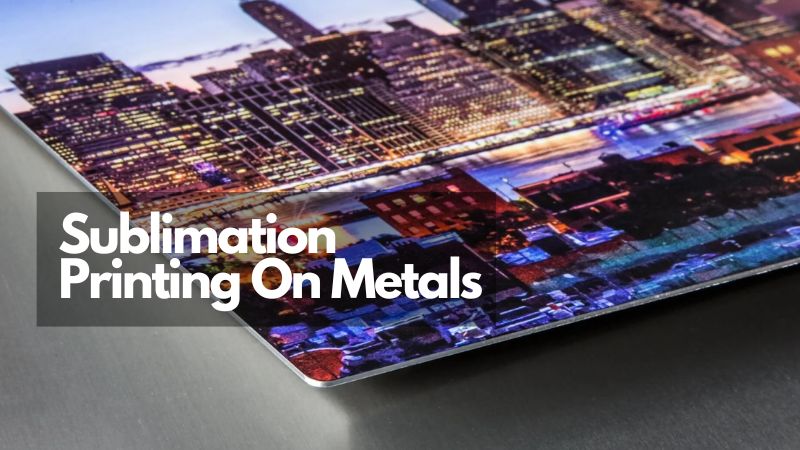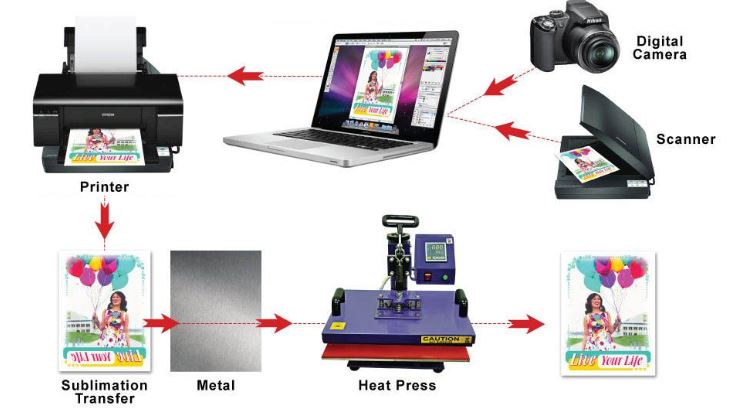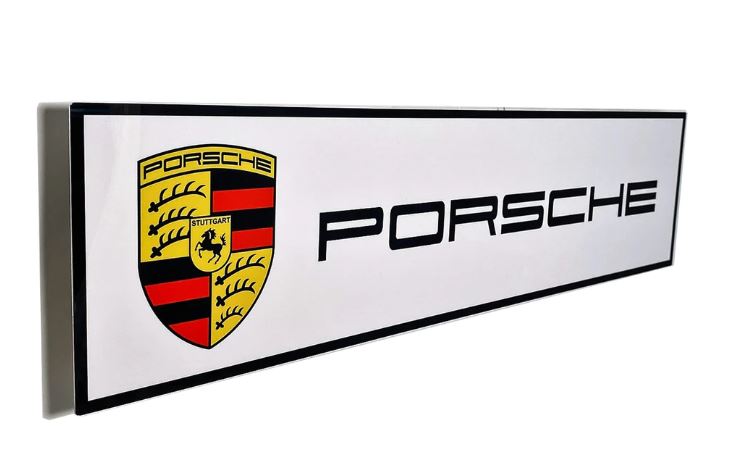
Sublimation printing is a popular technique you can use to print fabrics and metals. Whether you wish to print on a metal surface, or fabric it offers a convenient and cost-effective solution.
For this guide, you will learn everything about sublimation printing on metals – from design, and choosing material to the final printing process.
What is Sublimation Printing?

Sublimation printing uses a heat treatment process to fuse designs or patterns on metal surfaces. It creates durable and high aesthetic value prints on metal surfaces.
Advantages of Dye Sublimation Printing
There are many reasons why metal fabrication shops are opting for sublimation printing on metals:
It is a Smart Choice for Mini Production
This method is the best option for a person working on small production while maintaining a low budget.
Dye Sublimation is Very Durable
The process allows a permanent infusion of the color prints to the metal. Therefore, making them resistant to damage, hence very long-lasting.
Ability to Withstand High Temperatures
During sublimation printing on metals, you will use a heat press. This enables the dye to permanently infuse with metal without changing to molten form.
Aesthetic Value
Metals undergoing dye sublimation printing can maintain the original bright colors due to permanent bonding.
Resistant to Damage
The process of dye sublimation on metals enables permanent infusion preventing any chances for peeling and scratching.
Easy Maintenance and Cleaning
You can easily clean sublimated metal parts. Remember, your patterns will stick permanently on the surface. As a result, you can easily clean the surface without damaging the prints.
Multiple Finishes Available
Sublimation printing on metals results in various finishes such as clear, gloss, and mate.
Multiple Finishes Available
Sublimation printing on metals results in various finishes such as clear, gloss, and mate.

Drawback of Sublimation Printing on Metal Surfaces
Even as you choose sublimation printing for metals, it is also worth noting that.
· Initial Investment is High
Sublimation printing machine for metal is expensive. However, this is a one-time expenditure. Once you invest in high-quality sublimation printing machines, the operational costs are affordable.
· Recycling is not Practical
Ink splash can occur during the transfer process hindering possible recycling process.
Choosing Metals for Sublimation Printing Process
Dye sublimation is a practical printing technology you can use on many metals. Some popular materials include:
1. Sublimation on Aluminum Sheet Metal
Aluminum is known for:
- Lightweight
- Corrosion resistance
- High strength
- Versatility
As a result, you can use aluminum for many products such as hydro flasks, tumblers, signage, etc. With the invention of this technology, sublimation on aluminum sheets offers unlimited design options.
2. Sublimation Printing on Steel
Among the steel families, stainless steel remains a popular material for sublimation printing on metals. This is due to excellent properties such as:
- Corrosion resistance
- Easy to clean and maintain
- Excellent strength
- Durability
When you are sublimating steel, remember, they tend to retain heat for a long time. Therefore, you should allow for maximum cooling.
Again, steel tends to have poor adhesion.
For this reason, before you sublimate on stainless steel, apply a polyester coating. It will help the sublimation ink adhere to the stainless steel surface.
With correct treatment, dye sublimation printing is suitable for virtually all metals. That is, for metals with good adhesion properties.
At times pre-treating the metal surface and then printing may be costly. A reason, you can opt for other printing alternatives such as screen printing on metal or UV printing on metal.
Tip: Remember, metals have good thermal properties. Therefore, they will heat faster. So, focus on the following when printing:
- Regulating temperature
- Checking pressure
- Proper timing
- Never remove the sublimation paper before the metal cools.
- Pressure during printing should vary from low to medium
Step-by-step Sublimation Printing on Metal
A successful and quality output from sublimation printing is a sequential process.
It first begins by having the right accessories you want to use for the dye sublimation printing on the metal surface.
You should have the following:
· Sublimation Printer
It prints the design on the transfer paper or sublimation paper.
· Sublimation Ink
Choose suitable ink that matches your designs and requirements.
· Transfer Paper/Sublimation Paper
This is a pre-treated sheet of material with a protective coat that allows for permanent bonding during sublimation.
You will print your designs on the transfer paper.
· Metal you want to Print
Sublimation printing is a versatile process you can use to print many metal parts. You can print:
- Stainless steel
- Aluminum
- Galvanized metal, amongst others
· Heat Resistant Gloves
They will protect you from burns when handling hot metal sheets.
· Heat Press Machine
This is a very vital machine that we apply in passing on the design from the paper to permanently bond with the sheet metal.
Once you have these tools and equipment, you can start the actual metal printing process. The process involves the following key stages:
Stage 1. Create the Design
Design the image or pattern you want to print on sheet metal. You can use suitable software or design tool to create the best design for your sublimation printing process.
Stage 2. Print your Image Or Design on Transfer Paper
Once you have the design ready, it is now time to print it on the transfer paper. Inject technology remains a popular method for printing designs or patterns on transfer papers.
Ideally, at this stage, you will transfer the soft copy of your design into a hard copy. It will be on the transfer paper.
Stage 3. Prepare the Heat Press Machine
This prompts preheating heat press machine to obtain the ideal temperature. Remember, the sublimation temperature depends on the ink type and metal to print.
In most cases, the sublimation temperature may range from 350 to 400 degrees.
Stage 4. Prepare the Metal Sheet for Sublimation.
Prepare the metal sheet by first peeling off the protective cover from the printing side. You should ensure it is the side that faces up.
Again, this may involve pre-treating the metal for high-quality prints. At the same time, you must identify the exact section where you want to print your design on the metal surface.
Secondly, place the transfer sheet on top of the sheet metal and flip it to face down ready for pressing.
Stage 5. Transferring Image on Transfer Paper onto Metal Surface
Now, attach your transfer paper to the metal surface you had pre-treated. Once you have fixed the two properly, place them in your heat press.
You can begin by closing the heat press without placing the sheet metal and transfer paper. Usually, this will pre-heat the pad within the press.
Under the action of high temperature from the heat press and pressure, your image’s dye will sublimate. That is, it transforms from dye to gas.
The sublimated gas will be fused into the metal surface. Usually, during this time, a phenomenon called sublimation heat transfer occurs.
Usually, this process can take about 120 seconds. This may vary depending on the metal type and ink.
You will allow the metal to cool. As the dye cools, it forms a permanent print on the metal surface.
Ideally, they are fused beneath the metal surface.
Stage 6. Check Quality of Printed Metal
Check if the dye sublimation printed metal parts meet your quality specifications.
Arrange the finished designs facing away from each other to prevent the ink from mixing.

As you can see, metal sublimation printing is a straightforward process. By following the above 6 steps, you will get high-quality parts.
Factors Determining Quality in Sublimation Printing on Metal
Sublimation printing on metals, just like other techniques, has a set of attributes that we check to ensure they are fit for purpose.
The following are some of the attributes we look into to ensure quality; -a type of sublimation printer, the quality of ink, and sublimation metal temperature.
· Sublimation Metal Temperature
The various metals in place sublimate at different temperatures. You should choose the right temperature and ink for the sublimation process.
· Type of Sublimation Printer for Metal
You should choose a sublimation printer consisting of high-resolution power and must be fast in production.
The printer should give room for adjustments during the processing to ensure quality output.
· Quality of Sublimation Ink for Printing Metal
You should use an ink that is toxic-free and easy to dry to avoid spillage.
The ink should be of a quality that permanently bonds with the surface of the metal sheet, to prevent fading.
· Quality of Transfer Paper
Consider sublimation transfer papers that have the following properties:-
- Wrinkle-free transfer paper when they come in contact with ink’s moisture.
- Transfer paper that dries faster
- Choose high-temperature-resistant transfer paper
Applications of Sublimation Printing on Metal
Sublimation printing on metal has various excellent applications, among them are:
· Sublimation on Metal Signs
These are signages we make from the back plates of metals. They may be from various metals such as stainless steel, copper, and aluminum.
Sublimation on metal signs involves both outdoor and indoor uses. Moreover, they enhance the ambiance of the location and provide the permanence of the logo.
· Sublimation Photos on Metal
They are images that we sublimate on metal surfaces. Normally, these images are durable and provide a modern appearance.
Sublimation photos on metals are waterproof. Besides,
The images are highly resistant to scratches.
· Sublimation Metal Name Badge.
Usually, these offer identification in vast areas, such as to the employees of an organization.

· Sublimation Metal Trophy Inserts
The inserts personalize the specific trophies by offering a figurine of what a person/team achieves.
Sublimating trophies offers sentimental value to trophies.

Conclusion
Sublimation printing on metals depends on heat transfer and fusing patterns on metals’ surfaces.
It is a versatile process you can use on many metal markings, branding, and printing. For any questions or inquiries on the sublimation metal printing process – contact us now.
More Resources:
Dye Sublimation – Source: DNPE
How to Print on Sublimation Metals – Source: Print Owners
Sublimation on Metals – Source: Angie Holden
Sublimation on Aluminum – Source: PDS




